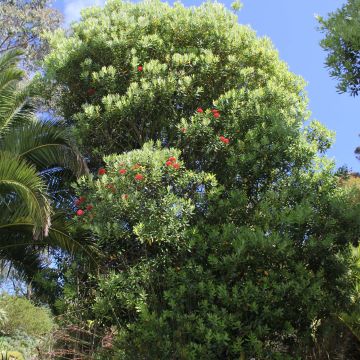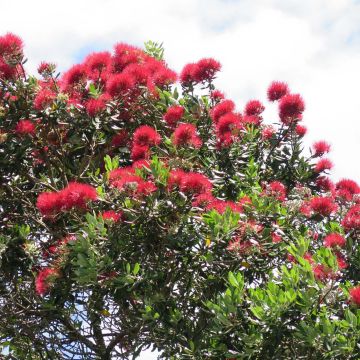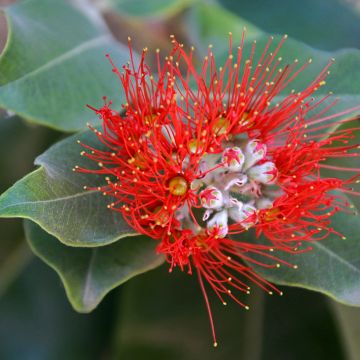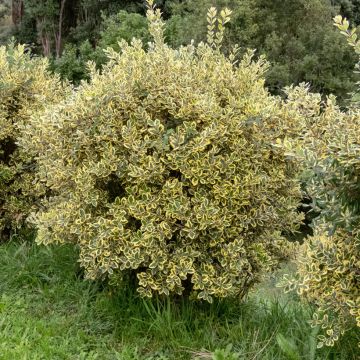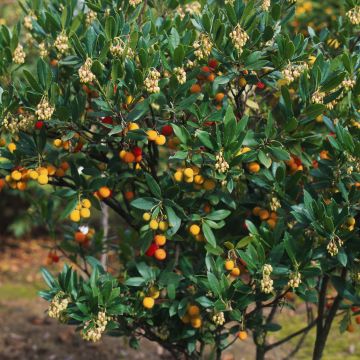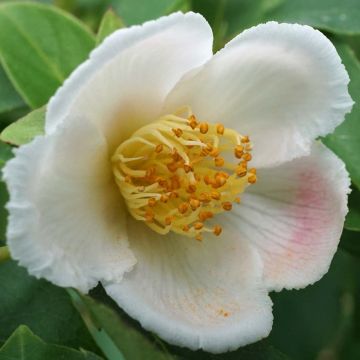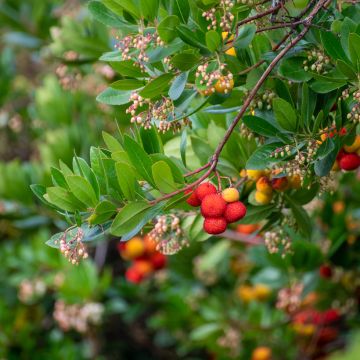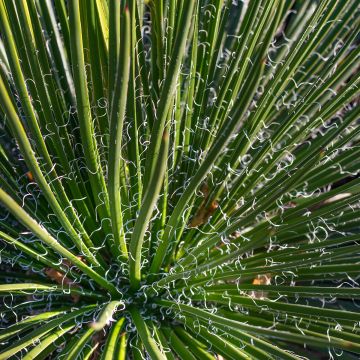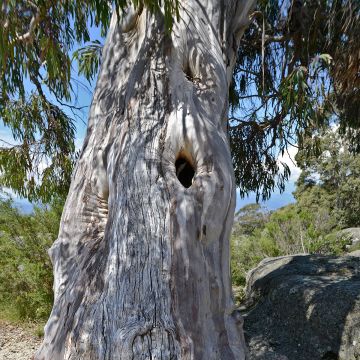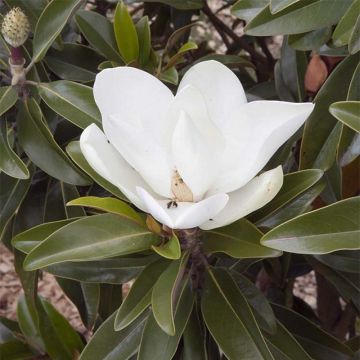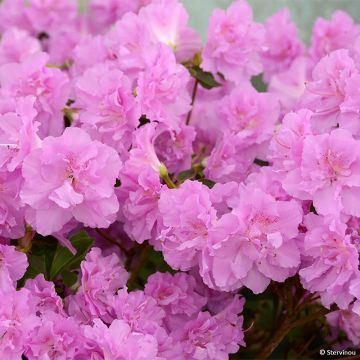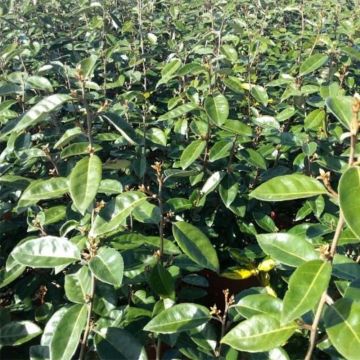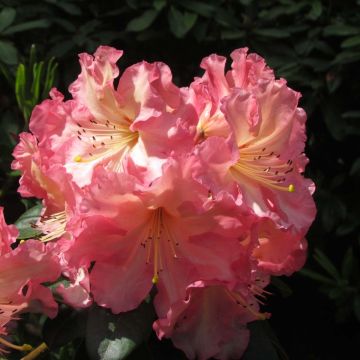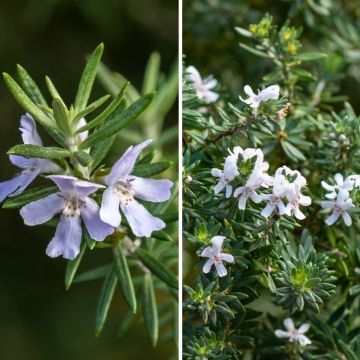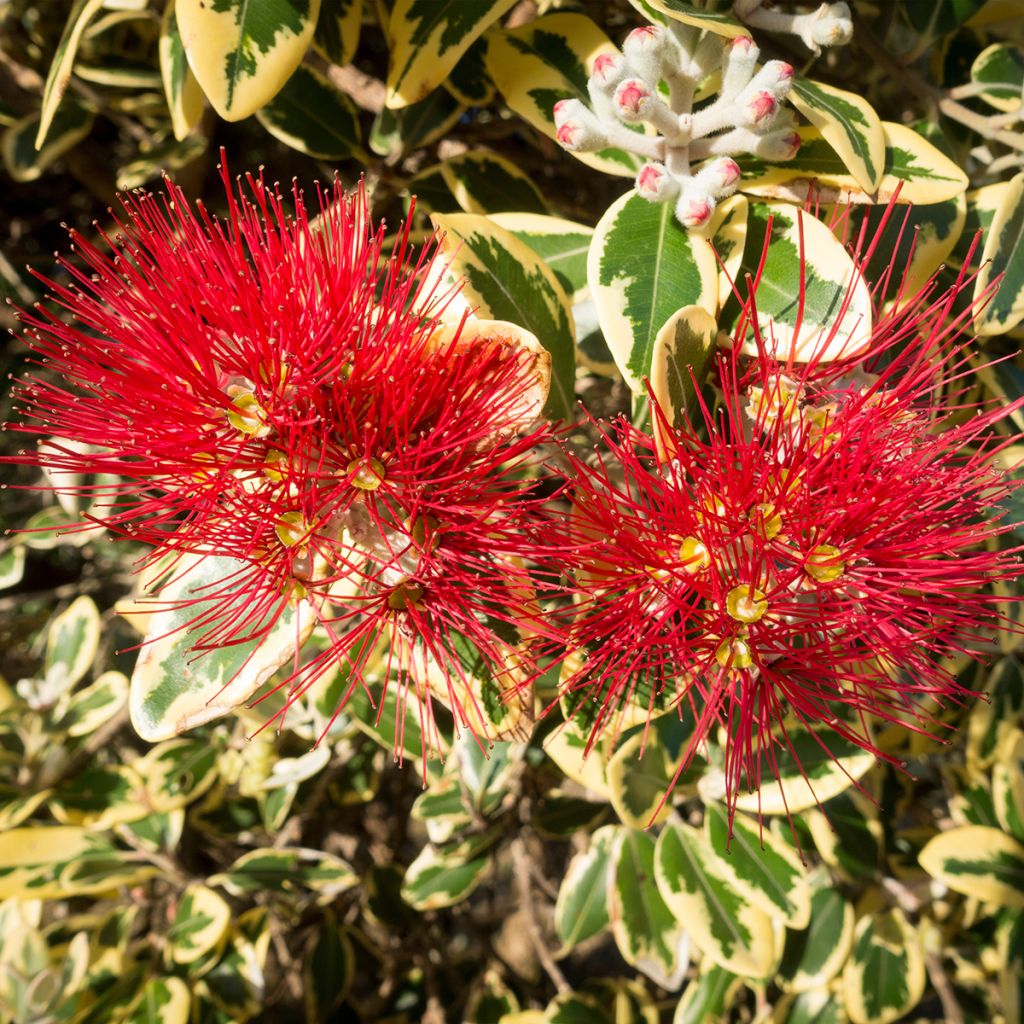

Metrosideros excelsa Aureomarginata ou M. kermadecensis Variegata - Arbre de Noël de Nouvelle-Zélande
Metrosideros kermadecensis Aureomarginata
Metrosideros kermadecensis Aureomarginata
Kermadec Pohutukawa, New Zealand Christmas Tree
Why not try an alternative variety in stock?
View all →This plant carries a 24 months recovery warranty
More information
We guarantee the quality of our plants for a full growing cycle, and will replace at our expense any plant that fails to recover under normal climatic and planting conditions.
From €5.90 for pickup delivery and €6.90 for home delivery
Express home delivery from €8.90.
Does this plant fit my garden?
Set up your Plantfit profile →
Description
Metrosideros excelsa 'Aureomarginata' (Las Cunas), more commonly known as Metrosideros kermadecensis 'Variegata', is a selection of New Zealand Christmas tree, or "pohutukawa", interesting for its beautiful variegated foliage in light yellow, as well as its improved cold resistance. In the ground, in our latitudes, it slowly forms a small tree with a regular habit, appreciated for its striking flowering, with large clusters of scarlet stamens appearing in late spring and early summer. Metrosideros can also be a magnificent specimen planted in a large pot on a patio or even indoors in cold climates. It will maintain a modest size, no more than 2m (7ft) in height and 1m (3ft) in width.
The genus Metrosideros belongs to the Myrtaceae family, like myrtles, eucalyptus, and callistemon. Its name comes from the Greek word "metra", meaning the heart of a tree, and "sideros", meaning iron, alluding to the hardness of the wood of these plants. Its vernacular name, New Zealand Christmas tree, originates from its flowering period, which occurs around Christmas time in its country of origin. There, this large and beautiful tree can reach heights of up to 20m (66ft). It prefers slightly acidic to neutral soil and dislikes the presence of limestone. The hybrid form 'Variegata' can withstand temperatures as low as -4 to -5°C (24.8 to 23°F) at its coldest. It is also drought-resistant.
When grown in pots, its habit is bushy, rather spreading, and barely arborescent. Its naturally ramified growth is slow. Its rather corky bark is grey-brown in colour. Over time, aerial roots may appear at the base of the very stout trunk, as well as along its entire length and on the knotty branches. The branches bear entire, ovate, leathery leaves with a slightly undulated edge, dark grey-green in colour, randomly maculated and/or bordered with yellow, and almost white and velvety on the underside. They measure 5 to 6cm (2in) in length and 2 to 3cm (1in) in width. Flowering mainly occurs from June to July. At the tips of the branches, clusters of beautiful flowers appear, composed of numerous 3cm (1in) long red stamens, forming large scarlet pompoms. They are nectar-rich and attract certain birds and numerous pollinating insects. The seeds take a year to mature. The root system of this plant is well-developed. Aerial roots can penetrate the ground, forming a small tree with multiple trunks.
Metrosideros kermadecensis 'Variegata' is a beautiful exotic bush to be grown as a conservatory plant where it will live for many years. In a greenhouse or conservatory, it will create an extremely decorative duo with a Tibouchina or a mimosa. To complete an exotic décor, also consider palm trees, Banksia integrifolia, and callistemons. In the most protected sites, it can be grown in the ground. It is not afraid of strong winds or salt and withstands water scarcity well.
Report an error about the product description
Metrosideros kermadecensis Aureomarginata in pictures
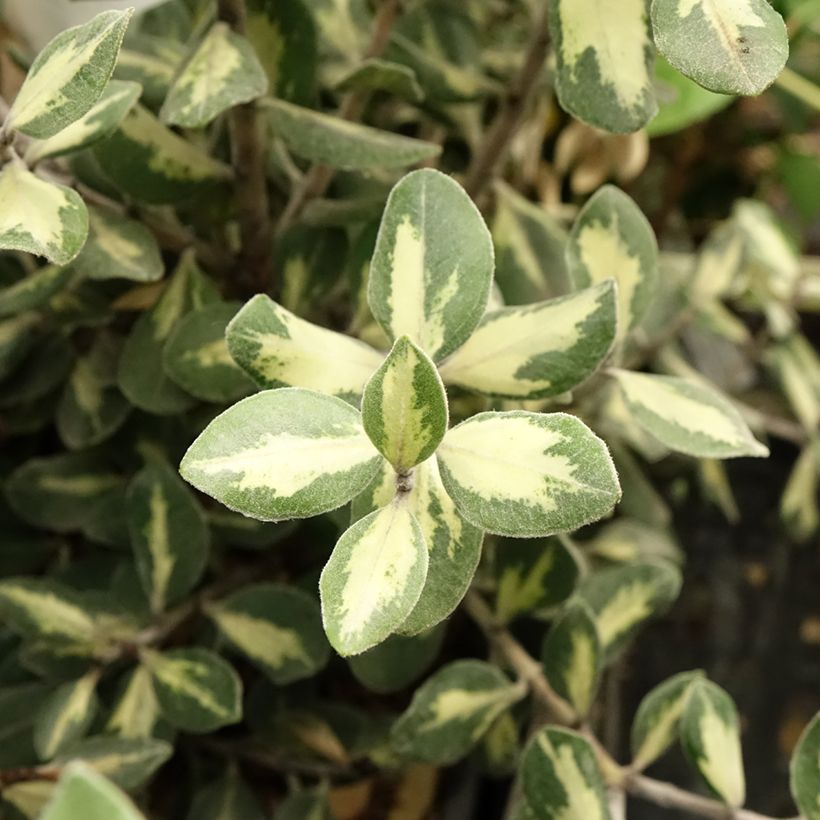

Plant habit
Flowering
Foliage
Botanical data
Metrosideros
kermadecensis
Aureomarginata
Myrtaceae
Kermadec Pohutukawa, New Zealand Christmas Tree
Oceania
Other Metrosideros
Planting and care
It will thrive in light soil, preferably slightly acidic and not too poor, humus-rich, well-drained, rather dry in winter, and slightly moist in summer, especially if grown in a pot. However, this is a relatively accommodating bush in terms of soil, which tolerates a little bit of limestone and copes quite well with summer drought once well rooted, after 3 years of cultivation in open ground. Soil drainage is very important to promote better cold resistance. It does not like heatwaves, but tolerates sea spray and wind very well. Plant it after the last frost. It will flourish in full sun or partial shade. Its frost resistance does not exceed -5 °C (23°F) for short periods when mature. Young plants are less frost resistant than their older counterparts: grow them in pots until they reach a minimum height of 50cm (20in). Protect it with winter covering, and insulate it from the cold as much as possible. Place it in the warmest corner of the garden, in full sun, against a south-facing wall.
It will often be necessary to cultivate this bush in a large pot for overwintering, in a bright, well-ventilated but unheated room.
To shape it, you can prune the stems in autumn or after flowering to remove any annoying or unsightly branches and dead wood.
Cultivation in pots:
Ensure good drainage at the bottom of the pot (layer of gravel or pottery shards), which should be of a large volume. Use a light substrate, enriched with river sand, ericaceous soil and leaf compost, and add a little slow-release fertiliser in spring. Water in summer with preferably not too calcareous water, ideally rainwater, allowing the soil to dry out between waterings. Mist the foliage in very hot weather. Reduce watering in winter. Repot once a year, in spring.
Planting period
Intended location
Care
This item has not been reviewed yet - be the first to leave a review about it.
Evergreen shrubs
Haven't found what you were looking for?
Hardiness is the lowest winter temperature a plant can endure without suffering serious damage or even dying. However, hardiness is affected by location (a sheltered area, such as a patio), protection (winter cover) and soil type (hardiness is improved by well-drained soil).

Photo Sharing Terms & Conditions
In order to encourage gardeners to interact and share their experiences, Promesse de fleurs offers various media enabling content to be uploaded onto its Site - in particular via the ‘Photo sharing’ module.
The User agrees to refrain from:
- Posting any content that is illegal, prejudicial, insulting, racist, inciteful to hatred, revisionist, contrary to public decency, that infringes on privacy or on the privacy rights of third parties, in particular the publicity rights of persons and goods, intellectual property rights, or the right to privacy.
- Submitting content on behalf of a third party;
- Impersonate the identity of a third party and/or publish any personal information about a third party;
In general, the User undertakes to refrain from any unethical behaviour.
All Content (in particular text, comments, files, images, photos, videos, creative works, etc.), which may be subject to property or intellectual property rights, image or other private rights, shall remain the property of the User, subject to the limited rights granted by the terms of the licence granted by Promesse de fleurs as stated below. Users are at liberty to publish or not to publish such Content on the Site, notably via the ‘Photo Sharing’ facility, and accept that this Content shall be made public and freely accessible, notably on the Internet.
Users further acknowledge, undertake to have ,and guarantee that they hold all necessary rights and permissions to publish such material on the Site, in particular with regard to the legislation in force pertaining to any privacy, property, intellectual property, image, or contractual rights, or rights of any other nature. By publishing such Content on the Site, Users acknowledge accepting full liability as publishers of the Content within the meaning of the law, and grant Promesse de fleurs, free of charge, an inclusive, worldwide licence for the said Content for the entire duration of its publication, including all reproduction, representation, up/downloading, displaying, performing, transmission, and storage rights.
Users also grant permission for their name to be linked to the Content and accept that this link may not always be made available.
By engaging in posting material, Users consent to their Content becoming automatically accessible on the Internet, in particular on other sites and/or blogs and/or web pages of the Promesse de fleurs site, including in particular social pages and the Promesse de fleurs catalogue.
Users may secure the removal of entrusted content free of charge by issuing a simple request via our contact form.
The flowering period indicated on our website applies to countries and regions located in USDA zone 8 (France, the United Kingdom, Ireland, the Netherlands, etc.)
It will vary according to where you live:
- In zones 9 to 10 (Italy, Spain, Greece, etc.), flowering will occur about 2 to 4 weeks earlier.
- In zones 6 to 7 (Germany, Poland, Slovenia, and lower mountainous regions), flowering will be delayed by 2 to 3 weeks.
- In zone 5 (Central Europe, Scandinavia), blooming will be delayed by 3 to 5 weeks.
In temperate climates, pruning of spring-flowering shrubs (forsythia, spireas, etc.) should be done just after flowering.
Pruning of summer-flowering shrubs (Indian Lilac, Perovskia, etc.) can be done in winter or spring.
In cold regions as well as with frost-sensitive plants, avoid pruning too early when severe frosts may still occur.
The planting period indicated on our website applies to countries and regions located in USDA zone 8 (France, United Kingdom, Ireland, Netherlands).
It will vary according to where you live:
- In Mediterranean zones (Marseille, Madrid, Milan, etc.), autumn and winter are the best planting periods.
- In continental zones (Strasbourg, Munich, Vienna, etc.), delay planting by 2 to 3 weeks in spring and bring it forward by 2 to 4 weeks in autumn.
- In mountainous regions (the Alps, Pyrenees, Carpathians, etc.), it is best to plant in late spring (May-June) or late summer (August-September).
The harvesting period indicated on our website applies to countries and regions in USDA zone 8 (France, England, Ireland, the Netherlands).
In colder areas (Scandinavia, Poland, Austria...) fruit and vegetable harvests are likely to be delayed by 3-4 weeks.
In warmer areas (Italy, Spain, Greece, etc.), harvesting will probably take place earlier, depending on weather conditions.
The sowing periods indicated on our website apply to countries and regions within USDA Zone 8 (France, UK, Ireland, Netherlands).
In colder areas (Scandinavia, Poland, Austria...), delay any outdoor sowing by 3-4 weeks, or sow under glass.
In warmer climes (Italy, Spain, Greece, etc.), bring outdoor sowing forward by a few weeks.

































